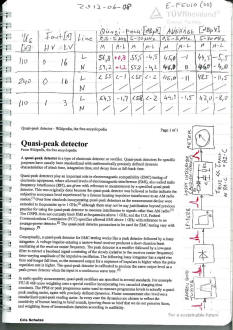|
RF Cafe visitor Cris Schulze saw the Design News article I linked to titled, "EMI Emissions Testing: Peak, Quasi-Peak, and Average Measurements,"
and has given permission to reprint his brief response to it (originally posted on LinkedIn).
The included notebook image includes an excerpt from Wikipedia's
quasi-peak
detector page, and he illustrates a block diagram of the test chain with de Forest's
audion circuit
that provides the fast rise-time and slow fall-time that characterizes it. A table of
actual test data compares quasi-peak measurements to average measurements.
  "Not really sure it is helpful, but I will share
my technical understanding here. While the RMS is a measure of the real power, i.e. the
equivalent thermal energy, of the signal, the peak value just describes the largest instant
magnitude (the amplitude) within a certain time range - which makes it a bit difficult
to measure. A bit more complicated is the quasi-peak measurement. The peak measurement
tries to detect the highest value, even of very narrow pulses - which have quite low
energy. But the pulse duration will have an effect to the disturbance of most systems,
thus the peak value alone will be have little meaning to most real systems. Then the
peak values will be formed, rectified to DC and integrated by a specified low-pass filter,
thus the resulting "quasi-peak" value will be higher for wider pulses and smaller for
shorter pulses. Then a quantitative value is generated which allows to compare the noise
measurements of any system. Most important is the so called audion-circuit (named by
Lee Deforest in 1906 - I think) which allows a quick charge and a slower discharge of
a capacitor and significantly determines the deflection of the voltmeter connected to
it. " "Not really sure it is helpful, but I will share
my technical understanding here. While the RMS is a measure of the real power, i.e. the
equivalent thermal energy, of the signal, the peak value just describes the largest instant
magnitude (the amplitude) within a certain time range - which makes it a bit difficult
to measure. A bit more complicated is the quasi-peak measurement. The peak measurement
tries to detect the highest value, even of very narrow pulses - which have quite low
energy. But the pulse duration will have an effect to the disturbance of most systems,
thus the peak value alone will be have little meaning to most real systems. Then the
peak values will be formed, rectified to DC and integrated by a specified low-pass filter,
thus the resulting "quasi-peak" value will be higher for wider pulses and smaller for
shorter pulses. Then a quantitative value is generated which allows to compare the noise
measurements of any system. Most important is the so called audion-circuit (named by
Lee Deforest in 1906 - I think) which allows a quick charge and a slower discharge of
a capacitor and significantly determines the deflection of the voltmeter connected to
it. "
- Cris Schulze
Director Technical Competence Center at TÜV Rheinland Japan Ltd.
References: CISPR (International Special Committee on Radio Interference )
 Audion Circuit Audion Circuit
Lee de Forest, U.S. 13,405A
Patented May 10, 1921
Posted August 10, 2018
|


 Audion Circuit
Audion Circuit